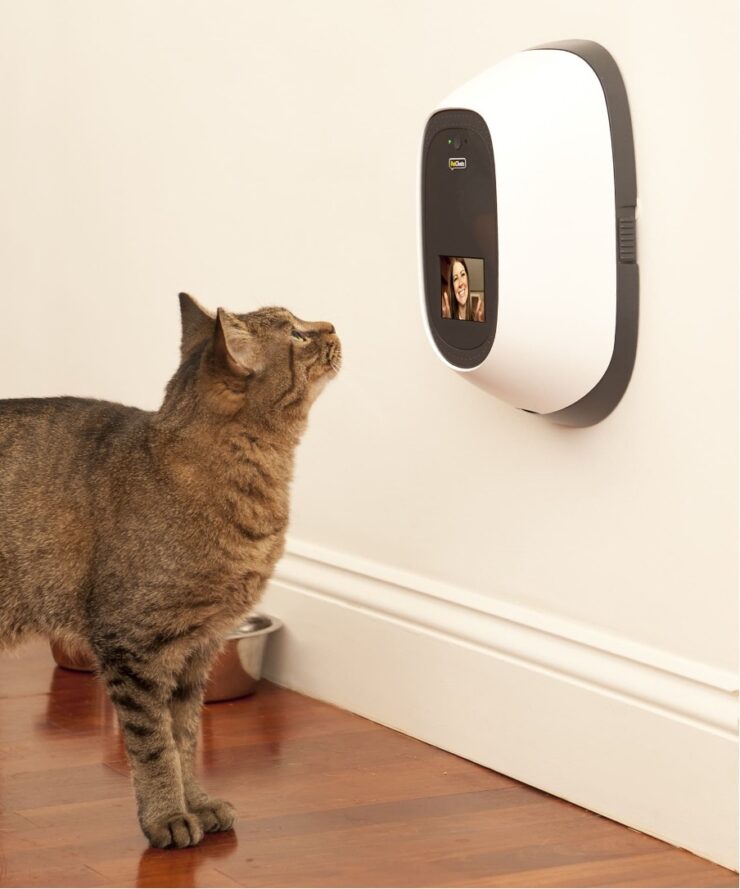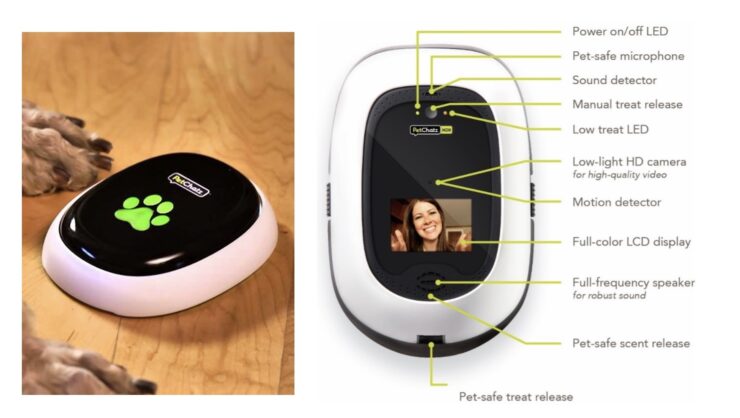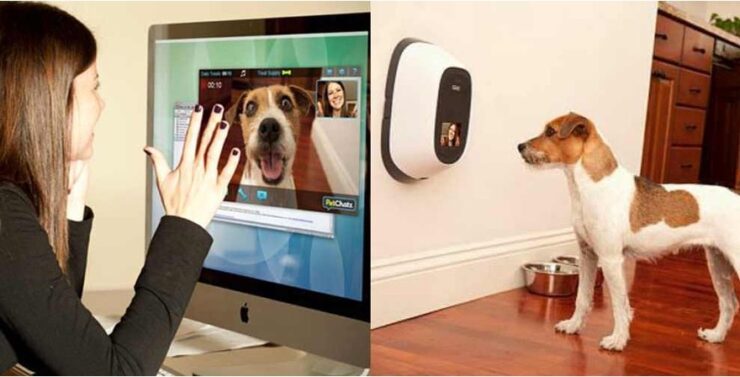DADeR
[DADeR/Presence] “(Radical) Presence and Ecology” – Eedi Karjalainen
Concepts: (radical) presence, ecology
Case Study: PetChatz
Abstract
Taking an ecological approach to smart object design shows how to equalise pet-owner relations. Evaluating PetChatz as containing qualities of radical presence enables a re-thinking of the smart object as beyond mediatory. The object finds it strengths in the way it has addressed the environment in which it is situated in and by going beyond the mere role of a moderator, as evidenced through the framework of radical presence and ecology. Through these qualities, the smart object manages to encourage mutual agency of owner and pet. If the smart object has radical presence, then the smart object must have the same level of agency as the users it mediates to initiate, moderate and experience the interaction.

Fig. 1 (above) – a cat viewing the display screen of the PetChatz device .
Wishful pet owners are often daunted by the prospect of having to leave their pet at home for extended periods of time. For many, leaving work mid-day to check on the animal is not a feasible task, yet knowing the animal is safe and well is a welcome thought. The concern for designing a smart object is clear: the separate environments of home and work need a mediator through which owner-pet interaction can be enabled. This has been tackled by PetChatz, voted the 2020 Best Dog Camera according to their website[1]. This smart object takes an ecological approach to design, attempting to equalise levels of human-pet communication. Deriving from notions of radical presence and ecology present in PetChatz, this entry proposes a de-hierarchisation of constituents as a dramaturgical advice specific to the design of mediatory smart objects.
Approaching smart object design from a performative understanding is productive in several ways. Employing a performance space “affords opportunities to engage with, and respond to, human and non-human entities” (Eckersall et al., 129). In other words, the performance space makes possible interactions between humans and robots which might otherwise (i.e. outside of the theatre space) be difficult to carry out. Since robots, referring in this case to smart objects, are intertwined in our everyday lives, they are assigned “productive roles” to account for their presence (118). These objects serve a purpose, and therefore their materiality is key. This materiality – an object’s qualities and characteristics – can “tell us what they do” and how they “exist within and around us” (119). The challenge, however, is achieving a state of emotional connection between a spectator and the object, prompting the case study for this text.
Case Study: PetChatz as a Smart Object
PetChatz is a smart object created specifically to function as a “digital daycare for the home alone pet” [2]. Advertised as going beyond a mere “treat camera”, PetChatz incorporates live video calling and recording to enable communication between owner and pet from a distance. The object has additional built-in features, including a remote-controlled treat dispenser, games, and videos for pets as well as aromatherapy for anxious animals. By pressing the “PawCall” button (see Fig. 2), a pet can alert their owner that they are in want of attention or a treat (‘PetChatz’). Functionally, PetChatz incorporates several user-friendly design elements (see Fig. 3): the object works by sound-and-motion-triggered technology, the “PawCall” button lights up and the pet camera plays a “PetChatz Tone” to alert the pet of their owner’s presence on the call. These design elements do not rely on verbal communication, thereby making it a functionally simple and direct object. Both the pet and owner have control of the interaction, and the owner can set scheduled timers to ensure the pet does not, for instance, over-indulge in treats. PetChatz aims to reduce pet loneliness during its time home alone and reduce owner stress of leaving their pet at home.

Fig. 2 (above left) – the “PawCall” button, featuring a light to indicate activation / Fig. 3 (above right) – the “pet-safe” design features of the PetChatz interface
Interactions take place as live encounters, with the possibility of watching playbacks of recorded footage of the pet. Furthermore, an owner can save and share recorded content, promoting the circulation of funny and cute pet footage online. Each of the two users – the pet and the owner – are addressed in different ways. The pet is encouraged to exercise its autonomy when home alone, thus shifting its mode of communication from a physical to a digital realm. For instance, spontaneously nudging a human or barking will not be possible, so the pet will first have to establish contact with their owner. The pet is able to shift between modes of being; from that of roaming around the house, to engaging in a mediated dialogue with their owner. The owner, on the other hand, may perhaps sense qualities of control, as opposed to autonomy. The continual access to video footage, direct contact, and power to incentivise (through giving treats and setting timers for activities) creates a clear hierarchy between pet and owner, yet the pet’s ability to interact in return somewhat demarcates an owner’s ‘totalitarian’ power.

Fig. 4 (above) – An example of the two-way video interaction (Radical) Presence in the Absence of Embodiment
Examining the design features of PetChatz as a smart object enables a further performative analysis, namely looking at levels of presence present. Presence, within theatre studies, can be defined in many ways. Maaike Bleeker and Marco Roozendaal examine the term in relation to the design of smart objects: citing Patrice Pavis, presence is “situated” and directly related to the context of the (theatre) stage (Bleeker and Roozendaal, 49), and in the case of designing smart objects, establishing modes of presence is paramount (49). Here, the role of presence goes beyond a situatedness by the object demanding attention to its existence.
On a deeper level, presence is categorised into three different ranges by Erika Fischer-Lichte: weak (the “mere presence of a body on stage”), strong (“the performative
value of the body”) and radical (which “intertwines the semiotic and phenomenal
body”), in which she only accepts weak and strong ranges as applicable to objects (Demers, 290). Fischer-Lichte asserts that objects can only contain qualities of strong presence if they are altogether removed from embodiment processes. To clarify, presence can be likened to notions of intimacy and immediacy, forms which oftentimes seem to rely on the presence of a physical body in space. This human body is embodied, alive and present on stage. Fischer-Lichte, therefore, argues that the notion of radical presence, which relies on embodiment, cannot exist in relation to an object. Instead, she accepts objects as having physical presence on stage, but assigns them an “aura” (290). The only way to achieve radical presence, according to Fischer-Lichte, is by having an embodied mind as the epicentre.
Louis-Philippe Demers disagrees with this statement, asserting that machine performers are not mere props, but can be seen “equally as an embodied mind, the result of a staged construction given to the machine performer” (290). Demers distinguishes between the animated (i.e., structural) – and animate qualities, the latter defined as containing “some perceptible essence of inner motivation” (290). Distinguishing between such qualities of machine performers allows Demers to claim that machine performers can, in fact “be a body”, as opposed to merely “having a body” (290). To understand this notion further, the terms can be applied to PetChatz. Taking the place of the machine performer, this smart object clearly has a body: it has physical parameters; design elements which give it visual and functional characteristics and it sits – spatially – on a given location, most likely on a wall easily reachable for a pet. To understand PetChatz as being a body (and therefore classifiable as having radical presence) requires analysis to the animate qualities of the object. These animate qualities become visible when approached from an ecological standpoint.
On Ecology: Co-Presence in Ecosystems
Broadly speaking, ecology can view theatre as an environment, such as Baz Kershaw’s definition in Theatre Ecology, whereby ecology is used both metaphorically and theoretically to think about “the complex relationships among theatre, contemporary media, protest and society” (May, 247). Approaching the smart object as a set of relationships – following the thought of Felix Guattari – enables a more nuanced approach to ecology: this ecological approach requires a degree of “smartness”; not a measurable quantity of intelligence, but rather how an object’s behaviour is “designed to afford potentialities of the environment to be actualized” (Bleeker and Roozendaal, 52). In other words, the smartness of an object is measured by the degree with which it calls to action existing – but in that moment inactive – encounters, actions, or relations. What is needed is an inner motivation. This motivation can be linked to the programmed function of PetChatz: the need to enable human-pet connection and interaction. Its very functioning, as an object, rests on the premise of contact, connecting not only two sentient beings (human/animal), but two differing spatial environments (home/office).
An ecological understanding of performance has further been interrogated by Carl Lavery, as discussed in in his journal article in French Cultural Studies (Lavery). Although Lavery conducts his analysis on French artist Philippe Quesne’s work, the ecological aspect can be productively understood in the context of smart objects. Although Lavery points out significant limitations to the definition, Susan Sontag defines two ways – both essential to “the workings of an advanced industrial society” – in which cameras define reality, providing helpful insights into the ecological workings of PetChatz: first, the use of cameras as a “spectacle (for masses)” and second, as an “object of surveillance (for rulers)” (268). The save-and-share properties of video footage not only acts as a CCTV camera, ensuring pet safety (or a dystopian alternative?), but also acts as a spectacle for the masses: a way to share one’s pet’s daily shenanigans with family and friends. As Demers asserts, the machine performer (PetChatz) does not “act in isolation” but requires the “co-presence of the audience to be fully realized” (276). This functioning of images like natural ecosystems is opposed by Lavery’s depiction of the ecology of the image as an ecosystem in and of itself. Spatially, the small, minimalist design of PetChatz does not draw remarkable attention to it, nor does it create an “ecstatic experience of space”, but it manages to prompt reflections on how “small groups of human beings exist within and relate to their own ecosystems or habitats” (Lavery, 267). Through mutual insight into the daily activities of a pet, and the distanced contact with an owner, both parties gain insight into the habitat of the other, seeing how they relate to the environment in which they are in. Without being too presumptuous about animal consciousness, the human, at least, can witness their pet’s relation to space when no owner is present, revealing a pet’s mode of spending alone, ‘leisure’ time. By being an ecosystem, insight can be gained into how humans – and animals – exist “within the natural world as well as with each other” (269).
Assessing Ecologies of PetChatz
Employing an ecological approach to the design of PetChatz highlights the need to de-hierarchise the experience of space and environment between owner and pet. The use of a smart object as a mediator between two spaces shows the literal separation of habitats, but simultaneously brings about the merging of two states of being. This fluid encounter, enabled by the mediating PetChatz, allows the perceptive eye to “wander from fragment to fragment” (Lavery, 272), thereby removing hierarchies of interaction. While emphasising the difficulty of assessing a pet’s awareness of the situation, the distinction between the human and the animal (in terms of engaging with the mediated products i.e., the audio-visual footage displayed by PetChatz) is collapsed. Through an ecological understanding it becomes clear how “no object or being exists in isolation” (272).
Although the preceding argument emphasises the co-habitation of the human and the animal, enabled at a distance through the mediating smart object, a notable point concerns the redundancy of the human within ecology at large. Lavery argues for the displacement of the human being from the world’s centre (275), thereby calling for an alternative, less catastrophic lens with which to look at humanity’s demise. Although calling for an entirely separate essay, it is worthy to think about the removal of the human from the pet-object interaction in designing smart objects. The commands which the pet can carry out include notifying its owner (through the “PawCall” button) to either call or give a treat. Both commands require the presence and approval of a human on the other end of the call. The other commands, such as watching a program, listening to sounds or turning on the aromatherapy do not need direct, live interaction with a human, but require pre-installed timers, at which point – but only then – can the pet enjoy the amenities. Although a counterargument could certainly be developed questioning the very need of such applications, that would be a separate topic. Developing smart objects from an ecological perspective calls for the optimisation and actualisation of potentials within existing environments. Thus, PetChatz should enable continual access to the entertainment features. A pet will gain a greater sense of autonomy when it is not restricted by a pre-determined schedule, and the design features of the object (such as the light on the “PawCall” button could have either a continuous, (LED) light, or flash at steady, calm intervals, assuring the pet of its active state. The pet will have greater autonomy, albeit still restricted in full access, with which it can determine the encounters it has with the object, irrelevant of the owner’s availability. With these minor alterations, PetChatz could emphasise its likening to an animate body, increasing the extent to which it could actualise its body in the environment, thereby being a body.
Now What? Presenting DADeR
Taking an ecological approach to smart object design shows how to equalise pet-owner relations. Evaluating PetChatz as containing qualities of radical presence enables a re-thinking of the smart object as beyond mediatory. The object finds it strengths in the way it has addressed the environment in which it is situated in and by going beyond the mere role of a moderator, as evidenced through the framework of radical presence and ecology. Through these qualities, the smart object manages to encourage mutual agency of owner and pet. Functionally, the design of PetChatz is clear, as is the transformations it enables through interaction.
However, applying these evaluations to smart object design in general, it is crucial to assess the extent to which a mediatory object itself can be assigned agency. Whilst still acknowledging the co-constitutive implications on the object, removing the presence of those being mediated – such as the owner or the pet – proves challenging in the object’s effectiveness. Removing the enabling force of the interaction (the embodied human) from the object immediately limits the capacity at which the object can function. In designing a smart object, the designer needs to enable the object to actualise the environment in and of itself, without the need of a pet tapping a button, for instance. How can the object initiate the interaction between entities? Addressing this question would require developing the inner motivation of an object (and thereby its animate qualities) further. When an object’s purpose is to enable contact between two or more beings, it approaches the task mechanically: A needs to contact B, and the object enables this interaction. If, as we have argued, the smart object has radical presence, then the statement should read: A, B and C need to establish contact (C being the smart object), whereby each component has equal agency to initiate, moderate and experience the interaction. Emphasising the fluidity of this interaction will de-hierarchise the relations between each constituent, enabling more ways with which to actualise any given environment.
[1] See www.petchatz.com for product reviews
[2] (‘PetChatz’)
Bibliography
Bleeker, Maaike, and Marco C. Roozendaal. ‘Dramaturgy for Devices: Theatre as Perspective on the Design of Smart Objects’. Designing Smart Objects in Everyday Life: Intelligences, Agencies, Ecologies, edited by Betti Marenko et al., Bloomsbury Visual Arts, pp. 43–56.
Demers, Louis-Philippe. ‘The Multiple Bodies of a Machine Performer’. Robots and Art: Exploring an Unlikely Symbiosis, edited by Damith Herath et al., Springer Singapore Pte. Limited, 2016, pp. 273–306. ProQuest Ebook Central, http://ebookcentral.proquest.com/lib/uunl/detail.action?docID=4526373.
Eckersall, Peter, et al. ‘Robots: Asleep, Awake, Alone, and in Love’. New Media Dramaturgy, Palgrave Macmillan, 2017, pp. 107–34.
‘Interactive Pet Camera • Best Dog Camera 2020 • PetChatz®’. PetChatz, 9 Apr. 2018, https://petchatz.com/.
Lavery, Carl. ‘The Ecology of the Image: The Environmental Politics of Philippe Quesne and Vivarium Studio’. French Cultural Studies, vol. 24, no. 3, 2, pp. 264–78.
May, Theresa J. ‘Theatre Ecology: Environments and Performance Events (Review)’. Modern Drama, vol. 52, no. 2, 2009, pp. 247–49. Project MUSE, https://doi.org/10.1353/mdr.0.0110.

